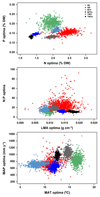Nutrient-rich plants emit a less intense blend of volatile isoprenoids
- PMID: 29120052
- PMCID: PMC6345376
- DOI: 10.1111/nph.14889
Nutrient-rich plants emit a less intense blend of volatile isoprenoids
Abstract
The emission of isoprenoids (e.g. isoprene and monoterpenes) by plants plays an important defensive role against biotic and abiotic stresses. Little is known, however, about the functional traits linked to species-specific variability in the types and rates of isoprenoids emitted and about possible co-evolution of functional traits with isoprenoid emission type (isoprene emitter, monoterpene emitter or both). We combined data for isoprene and monoterpene emission rates per unit dry mass with key functional traits (foliar nitrogen (N) and phosphorus (P) concentrations, and leaf mass per area) and climate for 113 plant species, covering the boreal, wet temperate, Mediterranean and tropical biomes. Foliar N was positively correlated with isoprene emission, and foliar P was negatively correlated with both isoprene and monoterpene emission rate. Nonemitting plants generally had the highest nutrient concentrations, and those storing monoterpenes had the lowest concentrations. Our phylogenetic analyses found that the type of isoprenoid emission followed an adaptive, rather than a random model of evolution. Evolution of isoprenoids may be linked to nutrient availability. Foliar N and P are good predictors of the type of isoprenoid emission and the rate at which monoterpenes, and to a lesser extent isoprene, are emitted.
Keywords: monoterpenes; nitrogen (N); nutrient availability; phosphorus (P); phylogeny; volatile organic compounds (VOCs).
© 2017 The Authors. New Phytologist © 2017 New Phytologist Trust.
Conflict of interest statement
The authors declare no conflict of interests.
Figures




Comment in
-
Introduction to a special feature issue - New insights into plant volatiles.New Phytol. 2018 Nov;220(3):655-658. doi: 10.1111/nph.15494. New Phytol. 2018. PMID: 30324737 No abstract available.
References
-
- Arneth A, Harrison SP, Zaehle S, Tsigaridis K, Menon S, Bartlein PJ, Feichter J, Korhola A, Kulmala M, O’Donnell D, et al. Terrestrial biogeochemical feedbacks in the climate system. Nature Geoscience. 2010;3:525–532.
-
- Beaulieu JM, Jhwueng DC, Boettiger C, O’Meara BC. Modeling stabilizing selection: Expanding the Ornstein-Uhlenbeck model of adaptive evolution. Evolution. 2012;66:2369–2383. - PubMed
-
- Beaulieu JM, O’Meara B. OUwie: Analysis of Evolutionary Rates in an OU Framework. 2016.
-
- Breheny P, Burchett W. Visualization of Regression Models Using visreg, R package version 2.2-0. 2015 http://cran.r-project.org/package=visreg, 10/12/2016.
-
- Carslaw KS, Boucher O, Spracklen DV, Mann GW, Rae JGL, Woodward S, Kulmala M. Atmospheric aerosols in the earth system: a review of interactions and feedbacks. Atmospheric Chemistry and Physics Discussions. 2009;9:11087–11183.
Publication types
MeSH terms
Substances
Grants and funding
- ERC-2013-SyG 610028-IMBALANCE-P/European Research Council Synergy/International
- 322603-SIP-VOL+/European Regional Fund (the Center of Excellence EcolChange)/International
- CGL2016-79835-P/Spanish Government/International
- SGR 2014-274/Catalan Government/International
- IUT-8-3/Estonian Ministry of Science and Education/International
LinkOut - more resources
Full Text Sources
Other Literature Sources

